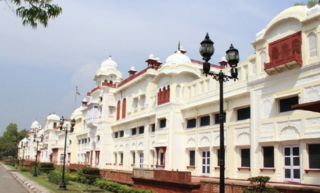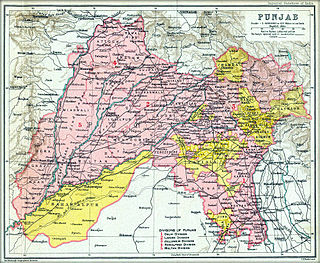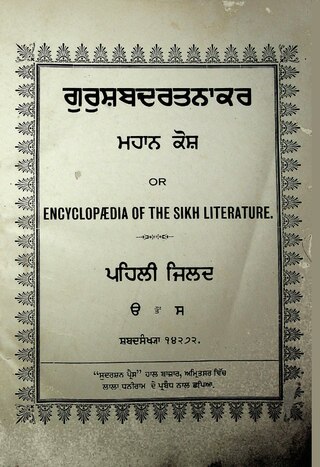
Patiala is a city in southeastern Punjab, northwestern India. It is the fourth largest city in the state and is the administrative capital of Patiala district. Patiala is located around the Qila Mubarak constructed by the Sidhu Jat Sikh chieftain Ala Singh, who founded the royal dynasty of Patiala State in 1763, and after whom the city is named.

Jindo district is one of the 22 districts of Haryana state in northern India. Jindo town is the administrative headquarters of the district. It is part of Hisar Division and was created in 1966.

The Cis-Sutlej states were a group of states in the contemporary Punjab and Haryana states of northern India during the 19th century, lying between the Sutlej River on the north, the Himalayas on the east, the Yamuna River and Delhi District on the south, and Sirsa District on the west. The small Punjabi kingdoms of the Cis-Sutlej states paid tributes to the Marathas, until the Second Anglo-Maratha War of 1803–1805, after which the Marathas lost this territory to the British.

Jind is one of the largest and oldest city in Jind district in the Indian state of Haryana. It is administrative headquarter of Jind district. Rani Talab is the main destination for tourists while Pandu Pindara and Ramrai are the main religious spots, attracting devotees for the holy bath during Amavasya.
Sidhu is a Punjabi Jat clan found in Punjab.

The Punjab States Agency was an agency of the British Raj. The agency was created in 1921, on the model of the Central India Agency and Rajputana Agency, and dealt with forty princely states in northwest India formerly dealt with by the Province of Punjab.

The Maharaja of Patiala was the title of a Maharaja in India and the ruler of the princely state of Patiala, a state in British India. The first Maharaja of Patiala was Baba Ala Singh (1695–1765).
Bhadaur is a town in Barnala district in the state of Punjab, India. It is part of the Bhadaur Assembly Constituency.

Rampura Phul is a city in the Bathinda district in the Indian state of Punjab. Phul Town serves as a Tehsil for villages in nearby area.

Guru Shabad Ratnakar Mahan Kosh, known by its more popular name of Mahan Kosh and by the English title Encyclopædia of the Sikh Literature, is a Punjabi language encyclopedia which was compiled by Bhai Kahn Singh Nabha over fourteen years. It was the first Punjabi encyclopedia, it contains more than 70,000 words, some of them has sufficient reference from Guru Granth Sahib, Dasam Granth, Gur Pratap Suraj Granth and from other Sikh books. It is considered a groundbreaking work in terms of its impact and its level of scholarship.
Malaudh was a Cis-Sutlej Phulkian princely state of India till 1846, after which it was merged into the Ludhiana District by the British when they annexed the territories around Ludhiana. The town of Malaudh, or Maloud, is situated at a distance of about 40 kilometres from Ludhiana on the Ludhiana-Malerkotla Road and is linked by approach road kup-payal road though village Rorian which is now part of it as Nagar Panchayat. It lies on 75°- 56' Longitude and 30° – 38' Latitude. Malaudh is a very ancient place which was known as Malla Udey or rise of the Mallas with whom Multan or Mallustan is associated and later got corrupted to Malaudh. There was a The Loharan about 1 kilometer on the southern side which has now disappeared. Malaudh has a government high school (co-educational), middle school for girls and a primary school for boys, a post office, primary health centre and a veterinary dispensary. Malaudh became a part of the Ludhiana District when it was formed out of the territories annexed by the British in 1846.

Nabha State, with its capital at Nabha, was one of the Phulkian princely states of Punjab during the British Raj in India. Nabha was ruled by Jat Sikhs of the Sidhu clan.

Hira Singh was the ruler of Nabha State, one of the Phulkian states in the Punjab.

Faridkot State was a self-governing princely state of Punjab outside British India during the British Raj period in the Indian sub-continent until Indian independence.
Sardar Nanu Singh Saini was a Sikh army general and a well-known jagirdar in Phulkian riyasat. He was a close associate of Maharaja Ala Singh who founded the Patiala state in 1753 AD.

The Post Office of India of the British Raj entered into postal conventions with a few native states of India. As per the postal convention, existing adhesive stamps and postal stationery of British India were overprinted with the name of the state for use within each convention State, for mail from one convention state to another, and to destinations in British India. The state administrations, in turn, had to conform to a number of agreements covering the issuance of stamps, the rates of postage, and the exchange of mail.

Jind State was a princely state located in the Punjab region of north-western India. The state was 3,260 km2 (1,260 sq mi) in area and its annual income was Rs.3,000,000 in the 1940s. Jind was founded and ruled by Jat Sikh rulers of Sidhu clan.

Patiala State was a self-governing princely state of the Empire of India, and one of the Phulkian States, that acceded to the Union of India upon Indian dominionship and partition. Patiala Kingdom/State was founded by Sidhu Jat Sikhs.

Phulkian Misl was a Sikh misl named after Choudhary Phul Singh.
Nawab Kapura Singh Brar (1625–1708) was the accredited progenitor of both the Faridkot and Kot Kapura minor Phulkian houses. Also responsible for founding the town of Kot Kapura in 1661.

















